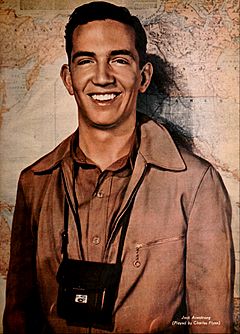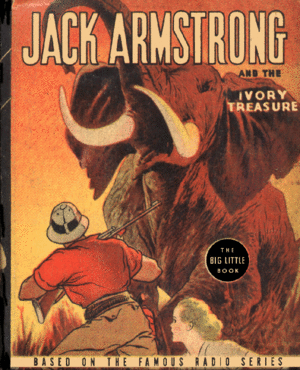Jack Armstrong, the All-American Boy facts for kids
Imagine a time before TV and the internet! Back then, radio shows were super popular. One of the most famous was Jack Armstrong, the All-American Boy. It was an adventure series that kept listeners hooked from 1933 to 1951.
The show first started in Chicago on July 31, 1933. It was heard on different radio networks over the years, including CBS, NBC, and finally ABC.
Contents
The Story Behind the Show
Jack Armstrong, the All-American Boy was created by a company called General Mills. They wanted to find a fun way to advertise their breakfast cereal, Wheaties. Samuel Chester Gale, who was in charge of advertising, came up with the idea.
Gale wanted to create a character that kids would look up to. He thought if Jack Armstrong ate Wheaties, then kids all over the country would want to eat them too! This idea led to the popular radio show.
The very first sung commercial for Wheaties was in 1926. It was a huge hit and was even sung on the Jack Armstrong show. The lyrics were:
Have you tried Wheaties?
They’re whole with all the bran. Won’t you try Wheaties? For wheat is the best food of man.
While Jack Armstrong was a made-up character, there was a real person named Jack Armstrong! He was a college friend of Sam Gale's. Gale liked his name and thought he seemed like a good, wholesome person. So, he decided to use "Jack Armstrong" for his new hero. The exciting adventures on the show were all made up, but the real Jack Armstrong often got teased about them!
Meet Jack and His Friends
The radio show was popular for many years. It followed the exciting adventures of Jack Armstrong, who was a great athlete at Hudson High School. Jack was played by Jim Ameche for a while, and later by Michael Rye.
Jack's friends, Billy Fairfield and his sister Betty, often joined him. Their Uncle Jim, James Fairfield, was a businessman. He often traveled to amazing places around the world for his work. And guess what? He would always take Jack, Billy, and Betty along!
Many of their adventures were like a travel guide. They taught listeners interesting facts about the different countries they visited. The show was created by writer Robert Hardy Andrews.
The show was always sponsored by Wheaties. In its final season, Jack graduated from high school and became a government agent. The show was renamed Armstrong of the SBI and changed from a short daily story to a longer, complete story each week.
Throughout the show's run, listeners could collect special prizes. These "radio premiums" were usually related to the adventures Jack and his friends were having.
Each episode began with a group of singers quietly performing the first line of the Hudson High School Fight Song: "Wave the flag for Hudson High, boys, show them how we stand. Ever shall our team be champions, known throughout the land."
Other Adventures
Jack Armstrong's popularity wasn't just on the radio! His stories were also turned into movies, books, and even comic books.
Jack Armstrong on Film
In a movie series from 1947 called Jack Armstrong, Jack (played by John Hart) is a science expert. He has to rescue his friend from an island fortress. His friend was kidnapped by a bad guy who wanted help building a death ray.
Jack Armstrong in Books
In 1936, two books about Jack Armstrong were released by Cupples & Leon. They were called Jack Armstrong's Mystery Eye and Jack Armstrong's Mystery Crystal.
Another book, Jack Armstrong and the Ivory Treasure (1937), was part of the Big Little Book series. It was based on a radio script. In 1939, a second Big Little Book, Jack Armstrong and the Mystery of the Iron Key, came out.
Jack Armstrong in Comics
The Parents Institute started publishing a Jack Armstrong comic book in 1936. It had 13 issues.
There was also a newspaper comic strip based on the radio series. It ran from 1947 to 1950.
Jack Armstrong on TV
A short animated TV pilot for Jack Armstrong was made by Hanna-Barbera. However, they couldn't get the rights to the characters. So, the planned series was changed and became the famous cartoon Jonny Quest (1964). You can even see some of the original Jack Armstrong animation in the closing credits of Jonny Quest!
Jack Armstrong in Video Games
Timothy Bottoms played Jack Armstrong in the video game American Hero (1995).
Honors
Jack Armstrong was recognized for its importance in radio history. It was added to the National Radio Hall of Fame in 1989.



